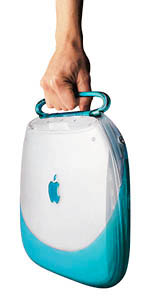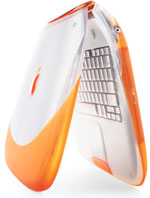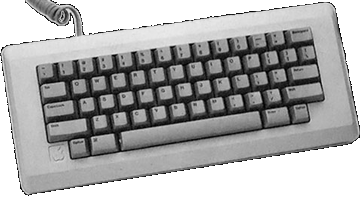iBook

Essentials
Family: iBook
Codename: P1, Bismol, Lanai
Gestalt ID: 406
Minimum OS: 8.6
Maximum OS: 10.3.9
Introduced: September 1999
Terminated: September 2000
Processor
CPU: PowerPC 750 "G3"
CPU Speed: 300 MHz
FPU: integrated
Bus Speed: 66 MHz
Register Width: 32-bit
Data Bus Width: 64-bit
Address Bus Width: 32-bit
Level 1 Cache: 32 kB data, 32 kB instruction
Level 2 Cache: 512 kB backside, 1:2
ROM: 1 MB ROM + 3 MB toolbox ROM loaded into RAM
RAM Type: SO-DIMM
Minimum RAM Speed: 100 MHz
Onboard RAM: 32/64 MB
RAM slots: 1
Maximum RAM: 288/320 MB
Video
Screen: 12.1" active matrix
GPU: ATI Rage Mobility (2x AGP)
VRAM: 4 MB
Max Resolution: 800x600
Storage
Hard Drive: 3.2/6 GB
ATA Bus: EIDE
Optical Drive: 24x CD-ROM
Input/Output
USB: 1
Audio Out: stereo 16 bit mini
Speaker: mono
Networking
Modem: 56 kbps
Ethernet: 10/100Base-T
Wi-Fi: optional 802.11b
Miscellaneous
Power: 45 Watts
Dimensions: 11.6" H x 13.5" W x 1.8" D
Weight: 6.6 lbs.

Announced in July 1999 at Macworld New York, the iBook was perhaps the most anxiously awaited Apple computer ever. Aimed at the same consumer market as it's big brother, the iMac, the iBook filled the 2x2 consumer/pro/desktop/portable matrix that Steve Jobs had first detailed more than a year earlier. Its specs closely resembled that of the iMac, with the same basic i/o options, and the same "closed system" concept. In order to bring the price down as far as possible, the design team removed the PC slots, IR, video-out and audio-in ports. The iBook also lacked a high-speed data-port, such as SCSI or firewire.
The iBook did have a number of semi-revolutionary features for such a low-end machine. It was the first Mac to include AGP-based graphics, and included a handle, a feature rarely seen in a portable. The iBook was the first Mac released using Unified Motherboard Architecture (UMA), which allowed Apple to standardize most motherboard components across all product lines.
The most exciting new feature of the iBook was the inclusion of AirPort, a wireless networking system based on existing industry standards. AirPort allowed up to 10 iBooks to connect to a single base-station, which could then be plugged into an existing ethernet network or a standard phone line. The iBook had an antenna built into the case, and a PC-card sized slot for the AirPort card.
While it was announced in July, the iBook did not ship until late-September, still in time for the back-to-school rush. At $1599, The iBook was $900 less expensive than Apple's lowest-priced professional PowerBook.
The iBook received a minor revision in February 2000, when the motherboard RAM was raised to 64 MB, and the hard disk was bumped up to 6 GB.
Picture Credits:
Apple, Inc.
